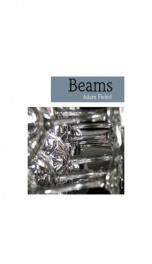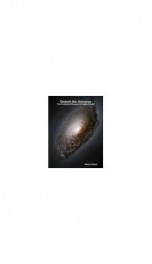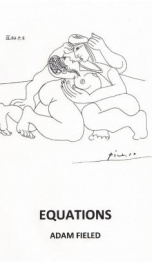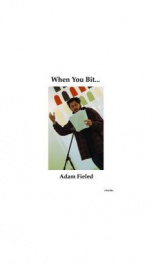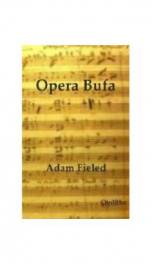Jeffrey Side on "Beams" (from Galatea Resurrects #9)
Beams by Adam Fieled is an e-book from Blazevox. It is a multifaceted work that is both formally and typographically inventive, as well as being linguistically intriguing. To do full justice to the poetry in this volume would require a much longer and detailed review of essay length; such is the complexity and multifaceted nature of this work. So all I will attempt in this review is to isolate certain features that can be readily recognised.
Beams comprises four titled sections: ‘Beams’, ‘Apparition Poems’, ‘Madame Psychoses’, and ‘Virtual Pinball’ (this latter being composed with poet Lars Palm). Each of these sections contain poems stylistically different to those of the other sections. An important aspect to the ‘Beams’ section is Fieled’s poetic aesthetic regarding it. The poems in it represent his concept of the poetic “beam”. The following is an extract from his exposition of this poetic, which can be read at http://artrecess2.blogspot.com/2005/08/beam-hypothesis.html:
[A beam is] a short poem, 8-20 lines [not] necessarily impersonal or personal, but it must transcend mere subjectivity […] single lines interspersed function as “beams of light”. They're pure shots into poetic space, flashes of imagery, insight, gist-phrasing, etc. Light-beams illuminate built-beams [ie architectural structures], built-beams support and buttress light-beams. Together, they posit the BEAM as a kind of “light-house” or “light-structure”.
The manifestation of this poetic aesthetic in the ‘Beams’ section applies to all of its poems, but other aspects tangentially related also pertain, particularly where colour (light) and matter (objects) are made to amalgamate in such a way as to produce an almost iridescent affect which draws attention to the “variability” that underlies phenomena (according to quantum theory). The aesthetic result is that material objects are seen to display less than palpable qualities: light becomes semi-palpable in ‘Creep’ (p.7) were it is described as ‘Sponge-light’, and in ‘Leaves’ (p.12) matter becomes semi-iridescent:
Leaves tonight are leaning
spots of light […]
The use of such affects serves to give us a sense of the underlying subatomic volatility that forms the objects of the observed world. It has a sort of Blakean sense whereby the visible world is seen to envelop a subtler one. The world is not all it seems to be. In doing this with words, Fieled makes almost tangible to our senses what can but remain only rational inference if we are reliant on same from a study of quantum physics. No small achievement for a poet.
However, the poems are not limited to such affects. They also manage to concisely represent the vicissitudes of human experience in all their variations. In ‘Razor’ (p.8) we find lines such as,
edged like needle-scars along arm-veins
everything I can’t puncture is there
which in association with the lines,
bottoms grow hardened from rubs
& sharpness be a baby’s candy
not only produce an interesting juxtaposition, but also represent birth and death. They suggest the bitterness, regret, and frustration that is the lot of humanity, yet they also suggest hope in that we become hardened in order for that suffering to become almost as acceptable to us as candy is to a baby.
Throughout this collection, a recurring motif relating to sexual struggle is evident. In ‘Sex Hex’ (p.9) we have a deft account of man’s unremitting desire for sexual fulfilment described in almost “biological determinist” terms, yet alluding to the nuances inherent in any discussion of male dominance within a given society, as is suggested by the mention of Foucault:
take her up, stroke her belly
she’ll think of Foucault
The biological controlling impulses of the male driven to physical action is counter-balanced by the cerebral passivity of the female who, by thinking of Foucault, both gives in to the male’s seduction ploy but also demonstrates an intellectuality that is not evident in the male at this particular moment in their relationship.
The problematical relationship between the sexes is further evinced in terms of consciousness in the ‘Madame Psychoses’ section. In ‘Sarah Israel’ (p.33) we see how memory almost reinvents or remodels the past regarding a yearned for “other”:
I saw her in a seeing not seen by any eye,
& the “I” that saw, saw my eye not at all.
Here, identity and perception become entwined as the punning of ‘eye’ with ‘I’ demonstrates. This punning acts as a poetic device to illustrate the very real inextricable union that identity and perception must necessarily have. It is a union so binding that the two become mutually exclusive causing the poet confusion as he struggles to wade his way through something of solipsist maze. In ‘Paula’ (p.37) we see the ultimate expression of male sexual and emotional yearning that represents the lot of Everyman:
chaos, order, clipped bird-like into
wings & cries. I could only ever
think; paula. all the thrusts &
pumps that could never be. "all"
that must be withheld, & that
it might be better that way.
you gave me the gift; savouring
wanting. how it really was you
I wanted. not a body but a soul.
I tell myself I've "been through
you", forever & never. zero here,
same as two. empty.saturated. dark
I have quoted the entire poem. Such is its universality pertaining to male desire any commentary by me would be more than superfluous. Indeed, it would not be outlandish to suggest that in this poem Fieled has articulated more than John Donne allowed himself to in those poems of Donne’s that evince similar concerns.
